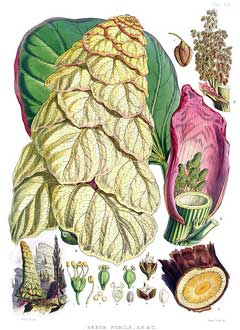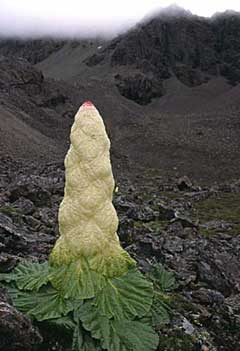 |
|
http://commons.wikimedia.org/wiki/File:Rheum_nobile.jpg |
 |
| © Bill Baker, Royal Botanic Gardens, Kew |
Translate this page:
Summary
Physical Characteristics

 Rheum nobile is a PERENNIAL growing to 1.5 m (5ft) by 1 m (3ft 3in).
Rheum nobile is a PERENNIAL growing to 1.5 m (5ft) by 1 m (3ft 3in).
See above for USDA hardiness. It is hardy to UK zone 7. It is in flower from July to August, and the seeds ripen from August to September. The species is hermaphrodite (has both male and female organs) and is pollinated by Wind.
Suitable for: medium (loamy) and heavy (clay) soils, prefers well-drained soil and can grow in heavy clay soil. Suitable pH: mildly acid, neutral and basic (mildly alkaline) soils. It can grow in semi-shade (light woodland) or no shade. It prefers moist soil.
UK Hardiness Map
US Hardiness Map
Synonyms
Plant Habitats
Cultivated Beds;
Edible Uses
Edible Parts: Stem
Edible Uses:
Leaf stem - raw or cooked[51, 105, 183, 272]. Pleasantly acid, this is a commonly used vegetable where it grows wild[2, 183].
References More on Edible Uses
Medicinal Uses
Plants For A Future can not take any responsibility for any adverse effects from the use of plants. Always seek advice from a professional before using a plant medicinally.
Antiemetic Astringent Carminative Depurative Diuretic Laxative
The root is astringent, carminative, depurative, diuretic, purgative and tonic[51, 91, 240]. Small doses act as an astringent tonic to the digestive system, whilst larger doses act as a mild laxative[232]. The flowering stem is used in Tibetan medicine, it is said to have a sour taste and a heating potency[241]. It is antiemetic, diuretic and laxative[241]. It is used in the treatment of swellings and fullness of the abdomen as well as to rid the body of retained fluids[241].
References More on Medicinal Uses
Now available: PLANTS FOR YOUR FOOD FOREST: 500 Plants for Temperate Food Forests and Permaculture Gardens.
An important new book from PFAF. It focuses on the attributes of plants suitable for food forests, what each can contribute to a food forest ecosystem, including carbon sequestration, and the kinds of foods they yield. The book suggests that community and small-scale food forests can provide a real alternative to intensive industrialised agriculture, and help to combat the many inter-related environmental crises that threaten the very future of life on Earth.
Read More
Other Uses
An ornamental plant[1] hardy to about -15°c.
Special Uses
Food Forest
References More on Other Uses
Cultivation details
Prefers a deep, fertile, moderately heavy, humus rich, moisture retentive, well-drained soil in sun or semi-shade. Grows well in heavy clay soils. A very ornamental plant[1], it is hardy to about -15°c[200]. Plants have proved very difficult to grow in cultivation in Britain[187]. Plants in this genus seem to be immune to the predations of rabbits[233]. Hybridizes freely with other members of this genus[200].
References Carbon Farming Information and Carbon Sequestration Information
Temperature Converter
Type a value in the Celsius field to convert the value to Fahrenheit:
Fahrenheit:
The PFAF Bookshop
Plants For A Future have a number of books available in paperback and digital form. Book titles include Edible Plants, Edible Perennials, Edible Trees,Edible Shrubs, Woodland Gardening, and Temperate Food Forest Plants. Our new book is Food Forest Plants For Hotter Conditions (Tropical and Sub-Tropical).
Shop Now
Plant Propagation
Seed - best sown in autumn in a shaded cold frame[200]. The seed can also be sown in spring in a cold frame. When large enough to handle, prick the seedlings out into individual pots and grow them on in the greenhouse or cold frame for their first winter, planting them out in the spring. Division in early spring or autumn[1, 111]. Divide up the rootstock with a sharp spade or knife, making sure that there is at least one growth bud on each division. Larger divisions can be planted out direct into their permanent positions. We have found that it is better to pot up the smaller divisions and grow them on in light shade in a cold frame until they are well established before planting them out in late spring or early summer.
Other Names
If available other names are mentioned here
Native Plant Search
Search over 900 plants ideal for food forests and permaculture gardens. Filter to search native plants to your area. The plants selected are the plants in our book 'Plants For Your Food Forest: 500 Plants for Temperate Food Forests and Permaculture Gardens, as well as plants chosen for our forthcoming related books for Tropical/Hot Wet Climates and Mediterranean/Hot Dry Climates. Native Plant Search
Found In
Countries where the plant has been found are listed here if the information is available
Weed Potential
Right plant wrong place. We are currently updating this section.
Please note that a plant may be invasive in one area but may not in your area so it’s worth checking.
Conservation Status
IUCN Red List of Threatened Plants Status :

Growth: S = slow M = medium F = fast. Soil: L = light (sandy) M = medium H = heavy (clay). pH: A = acid N = neutral B = basic (alkaline). Shade: F = full shade S = semi-shade N = no shade. Moisture: D = dry M = Moist We = wet Wa = water.

Expert comment
Author
Hook.f.&Thoms.
Botanical References
51200266
Links / References
For a list of references used on this page please go here
Readers comment